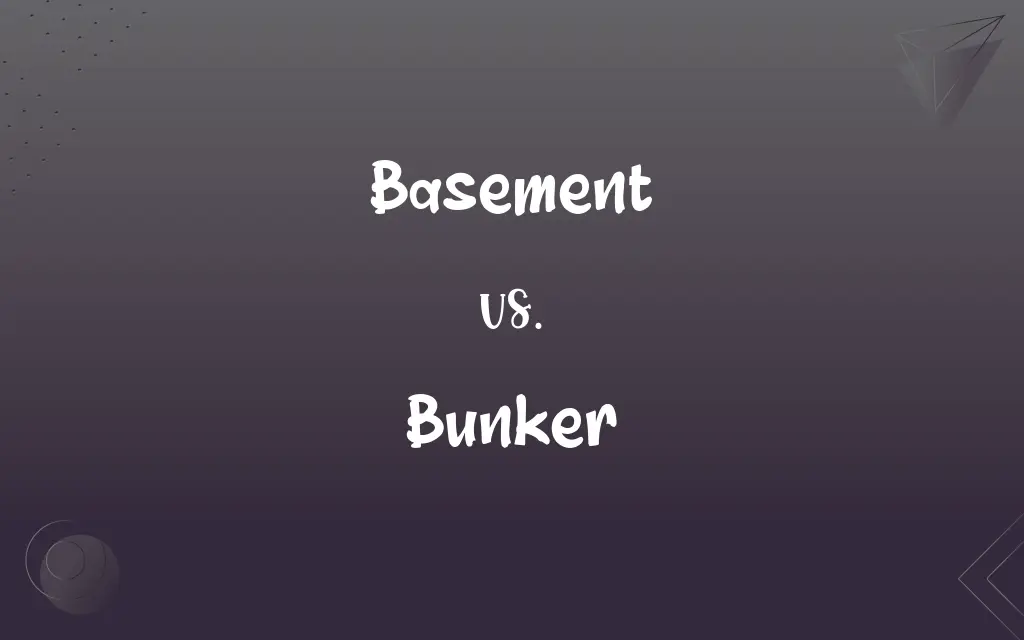Basement vs. Bunker: What's the Difference?
By Aimie Carlson & Janet White || Updated on May 23, 2024
A basement is a below-ground level part of a building used for storage or living space, while a bunker is a reinforced underground shelter designed for protection during emergencies.

Key Differences
A basement is a space located below the ground level of a building, commonly used for storage, additional living areas, or utilities like laundry rooms and heating systems. It is typically part of the overall structure and designed for regular use. A bunker, on the other hand, is an underground shelter specifically built to provide protection against extreme threats, such as military attacks, natural disasters, or nuclear fallout. It is heavily reinforced with thick walls and ceilings to ensure safety.
Basements are usually found in residential homes and commercial buildings, often with easy access via stairs from the main floor. They can be finished or unfinished, depending on their intended use and the owner's preferences. Bunkers are designed with a focus on security and survival, often featuring airtight doors, ventilation systems, and supplies for long-term occupancy. They are more likely to be located in strategic or remote locations rather than residential properties.
In terms of construction, basements are part of the building's foundation and typically built at the same time as the rest of the structure. Bunkers are often separate projects, constructed with materials specifically chosen for their durability and resistance to external threats.
While basements are used for everyday activities and storage, bunkers serve a specialized purpose, providing a safe haven during emergencies and ensuring the occupants' survival in extreme situations.
Comparison Chart
Primary Use
Storage, living space, utilities
Protection during emergencies
ADVERTISEMENT
Construction
Part of the building's foundation
Separate, heavily reinforced structure
Accessibility
Easy access from main floor
Often located in strategic or remote locations
Features
Can be finished or unfinished
Airtight doors, ventilation systems, survival supplies
Purpose
Regular use and everyday activities
Security and survival in extreme situations
Basement and Bunker Definitions
Basement
A below-ground part of a building used for storage or living space.
They converted their basement into a cozy home theater.
ADVERTISEMENT
Bunker
A reinforced underground shelter for protection.
The military built a bunker to withstand airstrikes.
Basement
A lower level in a home or building.
The basement was flooded after the heavy rain.
Bunker
A protective refuge against threats like attacks or disasters.
The family retreated to the bunker during the tornado warning.
Basement
A subterranean space typically accessed via stairs.
The kids play in the basement after school.
Bunker
A bin or tank especially for fuel storage, as on a ship.
Basement
An area below the main floor, often used for utilities.
The basement houses the water heater and laundry machines.
Bunker
Often bunkers Fuel, such as coal or fuel oil, used especially in ships.
Basement
The substructure or foundation of a building.
Bunker
An underground fortification, often with a concrete projection above ground level for observation or gun emplacements.
Basement
The lowest habitable story of a building, usually below ground level.
Bunker
(Sports) See sand trap.
Basement
A complex of undifferentiated igneous and metamorphic rocks underlying sedimentary strata.
Bunker
To store or place (fuel) in a bunker.
Basement
(Slang) The last place or lowest level, as in competitive standings.
Bunker
(Sports) To hit (a golf ball) into a sand trap.
Basement
Chiefly New England A public toilet, especially one in a school.
Bunker
(military) A hardened shelter, often partly buried or fully underground, designed to protect the inhabitants from falling bombs or other attacks.
Basement
A floor of a building below ground level.
Bunker
(nautical) A container for storing coal or fuel oil for a ship's engine; (by extension) the quantity of fuel needed to replenish that container.
Basement
(geology) A mass of igneous or metamorphic rock forming the foundation over which a platform of sedimentary rocks is laid.
Bunker
(rail transport) The coal compartment on a tank engine.
Basement
Last place in a sports conference standings.
Bunker
(sports)
Basement
The lowermost portion of a structure partly or wholly below ground level; often used for storage
Bunker
(golf) A hazard on a golf course consisting of a sand-filled hollow.
Basement
The ground floor facade or interior in Renaissance architecture
Bunker
(paintball) An obstacle used to block an opposing player's view and field of fire.
Basement
The foundation level of a building, sometimes finished.
They remodeled the basement to create an extra bedroom.
Bunker
A large bin or container for storing coal, often built outdoors in the yard of a house.
Bunker
(Scotland)
Bunker
A sort of box or chest, as in a window, the lid of which serves as a seat.
Bunker
(slang) A kitchen worktop.
Bunker
One who bunks off; a truant from school.
Bunker
The menhaden, any of several species of fish in the genera Brevoortia and Ethmidium.
Bunker
(nautical)
Bunker
(transitive) To load (a vessel) with coal or fuel oil for the engine.
Bunker
To take a load of coal or fuel oil for its engine.
Bunker
To steal bunker fuel by illicitly siphoning it off.
Bunker
To hit (a golf ball) into a bunker; to place (a golfer) in the position of having a golf ball in a bunker.
Bunker
To place (someone) in a position that is difficult to get out of; to hinder.
Bunker
To fire constantly at (an opponent hiding behind an obstacle), trapping them and preventing them from firing at other players; also, to eliminate (an opponent behind an obstacle) by rushing to the position and firing at extremely close range as the player becomes exposed.
Bunker
(intransitive) Often followed by down: to take shelter in a bunker or other place.
Bunker
A sort of chest or box, as in a window, the lid of which serves for a seat.
Bunker
A large bin or similar receptacle; as, a coal bunker.
Bunker
A small sand hole or pit, as on a golf course.
Bunker
Hence, any rough hazardous ground on the links; also, an artificial hazard with built-up faces.
Bunker
A fortified position dug into the ground, especially one which is closed on top and has protective walls and roof, e. g. of reinforced concrete. For defending positions it usually has windows to view the surrounding terrain, but as a safe location for planning operations or storage, a bunker may be completely underground with no direct access to the surface.
Bunker
To drive (the ball) into a bunker.
Bunker
A hazard on a golf course
Bunker
A fortification of earth; mostly or entirely below ground
Bunker
Hit a golf ball into a bunker
Bunker
Fill (a ship's bunker) with coal or oil
Bunker
Transfer cargo from a ship to a warehouse
Bunker
An emergency shelter designed to keep occupants safe.
They stocked the bunker with food and water for emergencies.
Bunker
A secure underground structure.
The bunker was equipped with advanced ventilation systems.
Bunker
A heavily fortified shelter, often used in warfare.
The soldiers took cover in the bunker during the bombardment.
FAQs
What is a basement?
A basement is a below-ground level part of a building used for storage or living space.
What are common uses for a basement?
Common uses for a basement include storage, additional living space, and housing utilities like laundry rooms.
How is a basement constructed?
A basement is part of the building's foundation, typically built at the same time as the rest of the structure.
How is a bunker constructed?
A bunker is a separate, heavily reinforced structure designed for maximum protection against external threats.
Can a basement be used as a living space?
Yes, basements can be finished and used as living spaces such as bedrooms, home theaters, or playrooms.
What is the main purpose of a bunker?
The main purpose of a bunker is to provide a safe shelter during emergencies.
What materials are used to build basements?
Basements are usually constructed with concrete, cinder blocks, or stone.
What is a bunker?
A bunker is a reinforced underground shelter designed for protection during emergencies.
Where are basements commonly located?
Basements are commonly located in residential homes and commercial buildings.
What are common features of a bunker?
Common features of a bunker include airtight doors, ventilation systems, and supplies for long-term survival.
What materials are used to build bunkers?
Bunkers are constructed with reinforced concrete and steel for maximum durability.
What is the main purpose of a basement?
The main purpose of a basement is to provide extra space for storage, utilities, and living areas.
Are basements designed for long-term occupancy?
Basements are not typically designed for long-term occupancy, though they can be used as additional living spaces.
Are bunkers designed for long-term occupancy?
Yes, bunkers are designed to support long-term occupancy during emergencies.
Can a bunker be used for storage?
Yes, bunkers can be used for storing emergency supplies, but their primary purpose is protection and survival.
Can a bunker be used for regular activities?
No, bunkers are typically used for protection during emergencies rather than for regular daily activities.
Where are bunkers commonly located?
Bunkers are often located in strategic or remote areas for enhanced security.
How do you access a basement?
A basement is usually accessed via stairs from the main floor of a building.
How do you access a bunker?
Bunkers are often accessed through secure, often concealed entrances.
Can a basement provide protection during emergencies?
Basements can provide some protection during certain emergencies, like tornadoes, but they are not as secure as bunkers.
About Author
Written by
Aimie CarlsonAimie Carlson, holding a master's degree in English literature, is a fervent English language enthusiast. She lends her writing talents to Difference Wiki, a prominent website that specializes in comparisons, offering readers insightful analyses that both captivate and inform.
Co-written by
Janet WhiteJanet White has been an esteemed writer and blogger for Difference Wiki. Holding a Master's degree in Science and Medical Journalism from the prestigious Boston University, she has consistently demonstrated her expertise and passion for her field. When she's not immersed in her work, Janet relishes her time exercising, delving into a good book, and cherishing moments with friends and family.































































